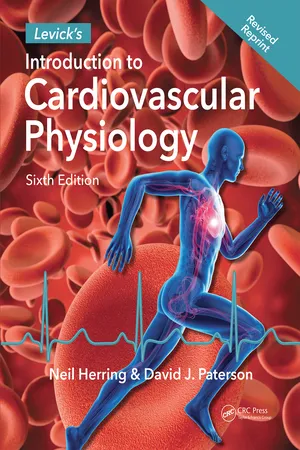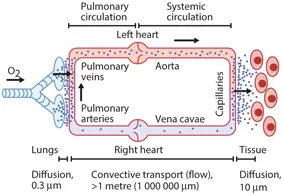
- 426 pages
- English
- ePUB (mobile friendly)
- Available on iOS & Android
eBook - ePub
Levick's Introduction to Cardiovascular Physiology
About this book
A sound knowledge of cardiovascular physiology is fundamental to understanding cardiovascular disease, exercise performance and may other aspects of human physiology. Cardiovascular physiology is a major component of all undergraduate courses in physiology, biomedical science and medicine, and this popular introduction to the subject is intended primarily for these students. A key feature of this sixth edition is how state-of-the-art technology is applied to understanding cardiovascular function in health and disease. Thus the text is also well suited to graduate study programmes in medicine and physiological sciences.
Frequently asked questions
Yes, you can cancel anytime from the Subscription tab in your account settings on the Perlego website. Your subscription will stay active until the end of your current billing period. Learn how to cancel your subscription.
At the moment all of our mobile-responsive ePub books are available to download via the app. Most of our PDFs are also available to download and we're working on making the final remaining ones downloadable now. Learn more here.
Perlego offers two plans: Essential and Complete
- Essential is ideal for learners and professionals who enjoy exploring a wide range of subjects. Access the Essential Library with 800,000+ trusted titles and best-sellers across business, personal growth, and the humanities. Includes unlimited reading time and Standard Read Aloud voice.
- Complete: Perfect for advanced learners and researchers needing full, unrestricted access. Unlock 1.4M+ books across hundreds of subjects, including academic and specialized titles. The Complete Plan also includes advanced features like Premium Read Aloud and Research Assistant.
We are an online textbook subscription service, where you can get access to an entire online library for less than the price of a single book per month. With over 1 million books across 1000+ topics, we’ve got you covered! Learn more here.
Look out for the read-aloud symbol on your next book to see if you can listen to it. The read-aloud tool reads text aloud for you, highlighting the text as it is being read. You can pause it, speed it up and slow it down. Learn more here.
Yes! You can use the Perlego app on both iOS or Android devices to read anytime, anywhere — even offline. Perfect for commutes or when you’re on the go.
Please note we cannot support devices running on iOS 13 and Android 7 or earlier. Learn more about using the app.
Please note we cannot support devices running on iOS 13 and Android 7 or earlier. Learn more about using the app.
Yes, you can access Levick's Introduction to Cardiovascular Physiology by Neil Herring,David J. Paterson in PDF and/or ePUB format, as well as other popular books in Medicine & Anatomy. We have over one million books available in our catalogue for you to explore.
Information
1 Overview of the cardiovascular system
1.1 Diffusion: its Virtues and Limitations
1.2 Functions of the Cardiovascular System
1.3 The Circulation of Blood
1.4 Cardiac Output and Its Distribution
1.5 Introducing ‘Hydraulics’: Flow, Pressure and Resistance
1.6 Blood Vessel Structure
1.7 Functional Classes of Vessel
1.8 The Plumbing of the Circulation
1.9 Control Systems
• Summary
• Further Reading
LEARNING OBJECTIVES
After reading this chapter you should be able to:
- outline the distance limitation of diffusive transport and the roles of diffusion versus convection in oxygen transport (1.1);
- list the differences between the pulmonary and systemic circulations (1.3);
- sketch out how blood pressure (BP), velocity and total cross-sectional area change from the aorta to the microcirculation and to the vena cava (Figure 1.10);
- write down the basic law of flow (1.5) and apply it to work out the main source of vascular resistance; sketch the structure of the blood vessel wall (Figure 1.11) and state the roles of the endothelium, elastin, collagen and vascular smooth muscle;
- name five main functional categories of blood vessel and state their roles (1.7);
- define a ‘portal circulation’ and explain its functional value (1.8).
The heart and blood vessels evolved to transport O2, nutrients, waste products and heat around the body rapidly. This is crucial for tissue viability, so the cardiovascular system (C VS) develops at an early stage in the embryo. However, very tiny organisms lack a circulatory system - their O2 needs are satisfied by diffusion from the environment. Even large animals, such as humans, rely on diffusion for the transport of materials between the bloodstream and cells. Why, then, do we also need a CVS? The answer lies in the distance limitation of diffusive transport.
1.1DIFFUSION: ITS VIRTUES AND LIMITATIONS
Diffusion is brought about by a molecular ‘drunkard’s walk’
Diffusion is a ‘passive’ transport process, in the sense that it is driven by the rapid, random thermal motion of molecules, not by metabolic pumps. When a concentration gradient is present, the randomly directed step movements of individual solute molecules result in a net movement down the concentration gradient, i.e. a net diffusive transport (Figure 1.1).
Distance dramatically slows diffusion
The rate of diffusive transport is important because nutrient delivery must keep up with cellular demand. Fortunately, diffusive transport is very fast over short distances; for example, diffusion from a capillary to tissue cell, a distance of ~10 p m, takes only ~50 ms. Unfortunately, as Einstein showed, the time t that randomly jumping particles take to move a distance x, in one specific direction, increases as the square of the distance:
(1.1)
Thus, diffusion is incredibly slow over long distances (Table 1.1). Over 1 cm, which is the thickness of the human left ventricle wall, diffusion would take more than half a day. Sadly, nature often reminds us that Einstein’s equation is correct. Figure 1.2 shows a section through a human heart after a coronary artery thrombus (clot) had blocked off the blood supply to the left ventricle wall. The pale area is cardiac muscle that died from lack of O2, even though the adjacent chamber is full of oxygenated blood. The patient died because just a few millimetres reduced the rate of diffusive O2 transport to a level that was too low to support life.
Table 1.1 Time taken for a glucose molecule to diffuse specified distance in one direction

Figure 1.1 Spontaneous molecular steps in a random direction lead to a net movement of solute molecules (dots) down a concentration gradient. The probability of a randomly directed step from compartment A to B is greater than from B to A because there are more solute molecules in A than B, per unit volume. Note that an individual molecule, such as the top one in B, may move ‘uphill’, that is, into the more concentrated solution. Net diffusion is thus the result of unequal ‘uphill’ and ‘downhill’ fluxes.

Figure 1.2 Section of the human left ventricle after a coronary thrombosis; the myocardium has been stained for a muscle enzyme. The pale area (marked with two *) is an ‘infarct’, an area of muscle damaged or killed by lack of O2. The pallor is due to the escape of enzymes from the dying muscle. The infarct was caused by a coronary artery obstruction, which halted the convective delivery of O2. O2 diffusion from blood in the main chamber (LV) is unaffected, yet only a thin rim of adjacent tissue (~1 mm) survived. (Courtesy of the late Professor M Davies, St George’s Hospital Medical School, London.)

Source: Einstein A. Investigations on the Theory of the Brownian Movement (trans. by Furth R, Cowper AD, 1956). New York: Dover Publications; 1905.
a Einstein’s equation states t = x 2/2D, where D is solute diffusion coefficient (glucose, 0.9 x 10−5 cm2 s−1 at 37° C; oxygen in water, 3 x 10−5 cm2 s−1, 37° C).
Convection provides fast transport over long distances
For distances of >0.1 mm, a faster transport system is clearly needed. The CVS provides this (Figure 1.3). The CVS still relies on diffusion to transport O2 across the short distance between gas and blood in the lungs; however, the absorbed O2 is then washed rapidly along in a stream of pumped fluid, covering a large distance in seconds (~3 cm s−1). This form of transport is called bulk flow or convective transport, and its energ y source is the contraction of the heart. Convective transport carries O2 a metre or more from the lungs to the smallest blood vessels of the human extremities in ~30 s, whereas diffusion would take more than 5 years! Nevertheless, diffusion takes over as the dominant transport process for the final 10-20 pm from blood to cell.

Figure 1.3 Overview of the human circulation, highlighting the relative roles of diffusion and convection in O2 transport.
1.2FUNCTIONS OF THE CARDIOVASCULAR SYSTEM
There are four main functions of the cardiovascular system, as detailed below:
- The primary function of the CVS is the rapid convective transport of O2, glucose, amino acids, fatty acids, vitamins, drugs and water to the tissues, and the rapid washout of metabolic waste products from the tissues (e.g. carbon dioxide (CO2), urea, creatinine).
- The CVS is also a control system. It distributes hormones to the tissues and secretes bioactive agents itself (natriuretic peptides, renin, nitric oxide, endothelin, prostaglandins).
- The CVS is crucial for body temperature regulation because it transports heat from deep organs to the skin surface and regulates heat loss from the skin.
- In reproduction, the CVS provides the hydraulic mechanism for genital erection.
1.3THE CIRCULATION OF BLOOD
The heart consists of two synchronous, muscular pumps, the right and left ventricles (Figure 1.4). Each pump is filled from a contractile reservoir, the right or left atrium. The right ventricle pumps deoxygenated blood through the pulmonary trunk to the lungs (Figure 1.5). Four pulmonary veins return oxygenated blood from the lungs to the left side of the heart, completing the short, low-pressure pulmonary circulation. The left ventricle pumps an equal volume of oxygenated blood to the tissues of the body. The tissues extract some of the O2, and the partly deoxygenated blood returns via two great veins, the superior and inferior vena cava, to the right atrium. This completes the long, high-pressure systemic circulation. One-way valves in the he...
Table of contents
- Cover
- Halftitle
- Title Page
- Copyright Page
- Table of Contents
- Foreword
- Preface
- A note on active and problem-based learning
- List of abbreviations
- 1 Overview of the cardiovascular system
- 2 The cardiac cycle
- 3 The cardiac myocyte: excitation and contraction
- 4 Initiation and nervous control of heartbeat
- 5 Electrocardiography and arrhythmias
- 6 Control of stroke volume and cardiac output
- 7 Assessment of cardiac output and arterial pulse
- 8 Haemodynamics: flow, pressure and resistance
- 9 Endothelium
- 10 The microcirculation and solute exchange
- 11 Circulation of fluid between plasma, interstitium and lymph
- 12 Vascular smooth muscle: excitation, contraction and relaxation
- 13 Control of blood vessels: intrinsic control
- 14 Control of blood vessels: extrinsic control by nerves and hormones
- 15 Specialization in individual circulations
- 16 Cardiovascular receptors, reflexes and central control
- 17 Co-ordinated cardiovascular responses
- 18 Cardiovascular responses in pathological situations
- 19 Experimental models and measurements to study cardiovascular physiology
- 20 Experimental perturbations to investigate cardiovascular physiology
- Clinical Cases for Problem-Based Learning
- Appendix 1 Human cardiovascular parameters
- Index